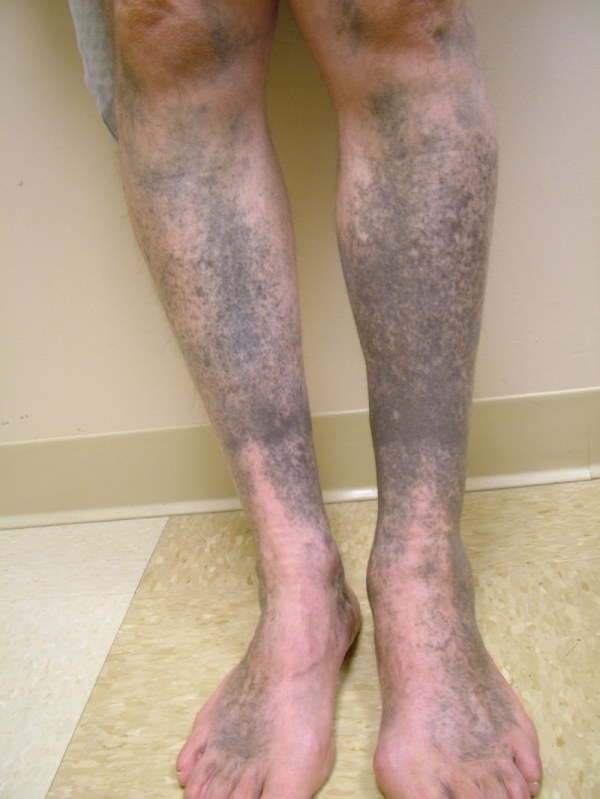 |
| Advertisement |
Minocycline is an antibiotic used to treat acne and inflammation, and one man who took it for 15 years to treat arthritis ended up with a permanent blue stain in the whites of his eyes.
This 70-year-old man took minocycline for many years and ended up with a permanent blue stain in his eyes.

The New England Journal of Medicine©2018.
After taking minocycline to treat inflammatory arthritis for 15 years, the whites of the man's eyes began to turn a bluish shade, as did his ears.
Dr. Rony Sayegh and his colleague at Case Western Reserve University School of Medicine in Cleveland, Ohio, published the details in a case report this week in the New England Journal of Medicine.
Minocycline is known to stain the skin, ears, fingernails, teeth, gums, and scar tissue, the authors note. The color is caused by the accumulation of iron and melanin, the pigment in skin, particularly in parts of the body exposed to sun.
The man's rheumatologist referred him to an eye doctor, who recommended that he stop taking the drug. He did, according to the report, but even a year later the bluish color remained.

An example of a patient (not the patient in the case report) with minocycline-related pigmentation.
Adam Friedman, MD, FAAD
Dermatologists are well aware of this potential side effect of minocycline, said Dr. Adam Friedman, associate professor of dermatology at the George Washington School of Medicine and Health Sciences in Washington, DC.
"This is a very well-established side effect that we see when people use this antibiotic too long," he said. "We tend to only see it when the cumulative dose of minocycline is well beyond what you should be using."
The fact that this person was on minocycline for 15 years is "somewhat obscene," he told BuzzFeed News. "We know that the longer you are on it, the higher the risk of this pigmentation."

An example of a patient (not the patient in the case report) with minocycline-related pigmentation.
Adam Friedman, MD, FAAD
You can get bluish-brown or gray marks in old scars, including acne scars, or a gray tinge in sun-exposed skin such as the face, ears, neck, and hands. There is also a third type that can affect the shins, giving them a dark brown appearance, Friedman said.
"We don’t see it that much anymore in dermatology, because everybody knows about it, so there’s really been such a push to not overuse this medication," he said.
"It can be quite disabling because it’s permanent," said Friedman. "It doesn’t go away after you stop [taking the drug]."
"It’s like a tattoo pigment; there aren’t really great ways to get rid of this," he said. "People have tried lasers but it doesn’t really work."

An example of a patient (not the patient in the case report) with minocycline-related pigmentation.
Adam Friedman, MD, FAAD
Dr. Friedman has seen this type of discoloration in his own practice, in patients who've been given minocycline by other doctors. "I really try to limit my use of oral antibiotics," he said.
Dermatologists use the tetracycline class of antibiotics because they have "very impressive anti-inflammatory properties," he said. "So we use them for acne, rosacea, scarring, hair loss, autoimmune disease — you name it. There is definitely a role for it, but you need to use them safely."
And it has to be a long period of time, generally more than three months, before the risk goes up.
"It is cumulative. It’s not like if you take it for seven days that you’ll get this," he said. It's only when taking it for long periods of time that this happens, although it's hard to determine exactly when is "too long." Although guidelines suggest you shouldn't take oral antibiotics for acne for longer than three months, he said.
Long-term use of any antibiotic can lead to drug-resistant bacteria and have a negative impact on the normal "good" bacteria that live on your skin and in your gastrointestinal tract.
And minocycline specifically can also have other rare side effects, including an inflammation of the pancreas and a lupus-like condition, Friedman said.
"I would say that you should not be on this, or truthfully any other antibiotic for acne, for longer than three months at any given time," he said. If you are prescribed antibiotics for acne for longer than three months, he recommends that you talk to your doctor about it. "They should push back," he said.


0 comments: